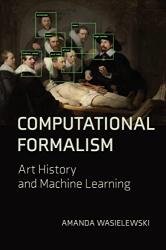 Название: Computational Formalism: Art History and Machine Learning
Название: Computational Formalism: Art History and Machine LearningАвтор: Amanda Wasielewski
Издательство: The MIT Press
Год: 2023
Страниц: 201
Язык: английский
Формат: pdf (true)
Размер: 37.7 MB
How the use of Machine Learning to analyze art images has revived formalism in art history, presenting a golden opportunity for art historians and computer scientists to learn from one another.
Though formalism is an essential tool for art historians, much recent art history has focused on the social and political aspects of art. But now art historians are adopting Machine Learning methods to develop new ways to analyze the purely visual in datasets of art images. Amanda Wasielewski uses the term “computational formalism” to describe this use of Machine Learning and Computer Vision technique in art historical research. At the same time that art historians are analyzing art images in new ways, computer scientists are using art images for experiments in Machine Learning and Computer Vision. Their research, says Wasielewski, would be greatly enriched by the inclusion of humanistic issues.
The main purpose in applying computational techniques such as Machine Learning to art datasets is to automate the process of categorization using metrics such as style, a historically fraught concept in art history. After examining a fifteen-year trajectory in image categorization and art dataset creation in the fields of Machine Learning and Computer Vision, Wasielewski considers Deep Learning techniques that both create and detect forgeries and fakes in art. She investigates examples of art historical analysis in the fields of computer and information sciences, placing this research in the context of art historiography. She also raises questions as which artworks are chosen for digitization, and of those artworks that are born digital, which works gain acceptance into the canon of high art.
“AI” is an umbrella term for contemporary digital automation methods that arrange and find patterns within the glut of data we produce. The implication of a term like AI is that intelligent machines are able to think, reason, and adapt in ways that mirror the behavior of biological organisms. However, the real-world applications of contemporary AI techniques are far more limited in scope than science fiction has conditioned us to believe. For this reason, I do not refer to the computational methods discussed in this book as AI, by and large. Instead, I speak about machine learning, a term that emphasizes the reflexive quality of contemporary algorithmic processing, and Computer Vision, a term that points to the pattern-recognition methods applied to images.
Скачать Computational Formalism: Art History and Machine Learning (The MIT Press)